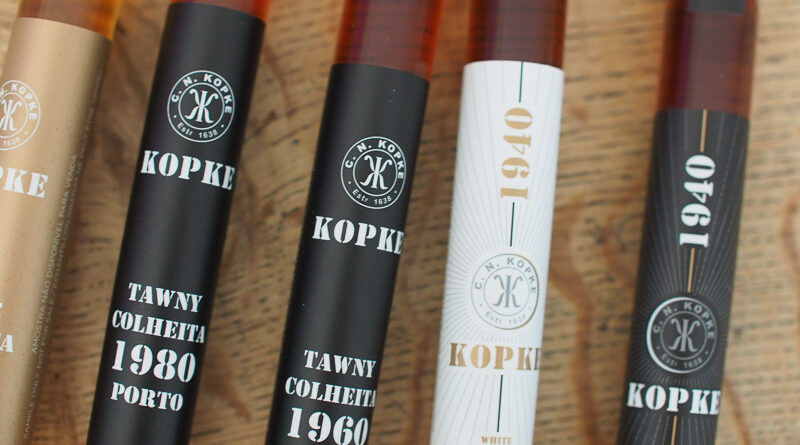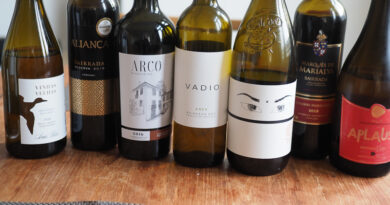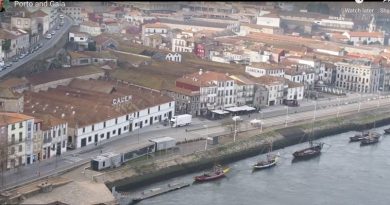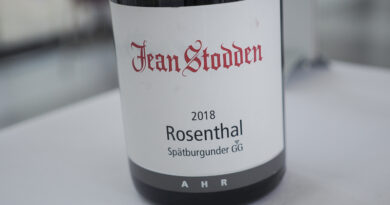Kopke Colheita Ports: a historic tasting going back to 1940
It’s not often you get to try wines from 1980, 1960 and 1940 in one tasting. Well, that’s what I did today, as part of a group of wine professionals connecting via the internet. As Zoom tastings go, this was a big one, with 37 participants from eight different countries. The benefit of dealing with Port is that it is quite easy to prepare tasting samples in test tubes and mail them out: old tawny-style Ports aren’t sensitive to oxidation.
The masterclass was hosted by Carlos Alves, winemaker, and João Belo from Sogevinus, the company who own Kopke as well as Burmester, Barros and Calem.
Belo explained that while that Anglo-Portuguese houses focused on ruby style Ports (bottle matured styles such as Vintage Port and Late-Bottled Vintage), Kopke and the other Portuguese houses have focused more on the tawny style – wines matured slowly in an oxidative way. As a result, they have cellars full of old Ports ageing in cask. ‘It is an incredibly valuable wine heritage that has been passed down by generations,’ he says.
How do they preserve this legacy in the cellars? Alves says, ‘It demands extra levels of care and precision. The art of blending is more complex than with the other tawny port styles. It is just one harvest so the options are very limited.’ In the cellar, they move barrels around to different locations which have different temperatures or humidity levels.
Kopke has a full range of aged white Ports too: this is one of their specialities. ‘Kopke has a unique range of white Ports, and they need constant overseeing,’ says Alves. They have their own characteristics.’
The disappearing sugar is interesting. As the wines get older they taste less sweet. The sugar level, though, doesn’t decrease, but instead increases with the concentration of the wine. But the older wines taste drier. This is partly because the acidity increases, but mainly because the aromas – which affect the perception of ‘sweetness’ – become more savoury, and the interpretation of the sugar level by the brain changes.
These wines are bottled to order from the cask. To prepare the wines for bottling, they do a little filtration just to remove any bits (it’s not a tight filtration) and then bottle the wine, with nothing else.
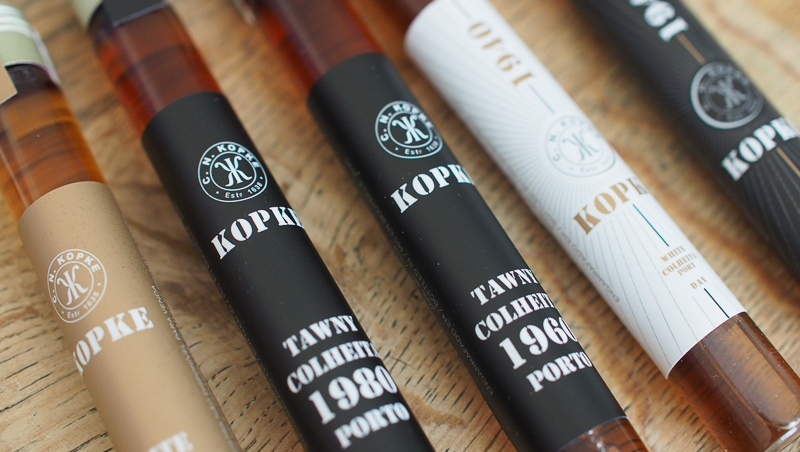
We began by looking at a relatively young white Port, which is now 17 years old.
Kopke White Colheita 2003 Douro, Portugal
This is mainly Viosinho, Gouveio, Rabigato and Malvasia Fina. 20% alcohol, pH 3.47, 4.04 g/l acid, 136 g/l sugar. The grapes are destemmed and are fermented on their skins in stainless steel lagares with robotic feet, at controlled temperatures (20-24 g/l). They don’t correct the acidity, but rather try to balance the wine with grapes with different states of maturation. The natural acidity is more constant over time. Brandy addition (77% proof) is a key choice – both the timing and quality. This is added in three different times to avoid damaging the fragile aromas of the white wine. The first stops the fermentation (up to 18%), then some more is added after 5-7 days when there is racking (up to 18.7), and the last addition is in January after the final blend is made (up to 20). 7500-15000 litre casks are used initially, then later it goes to 400-600 litre barrels. This is a golden/amber colour. It’s complex, lively and spicy with sweet nuts and some spicy depth, as well as some fruity notes: dried apricot and mango, as well as some yellow plums. Very powerful and lively with nice intensity. Very sweet, with richness and some raisin and old cask notes beginning to appear. Lovely complexity here but it needs more time for the sweetness and alcohol to fully harmonize. 93/100 (c £60)
Kopke Tawny Colheita 1980 Douro, Portugal
Variable growing season with poor flowering, and then a warm not hot summer with a delayed harvest at the end of September. Good quality but low quantity. A quarter each of Touriga Nacional, Tinta Roriz, Touriga Franca (this is Alves’ favourite) and Tinta Barroca. 20% alcohol, pH 3.52, 4.72 g/l acid, 132 g/l sugar. Fermented in stainless steel lagares with robitic feet, at 29-31 C. Brandy addition is at two moments: when fermentation is stopped, and five days later at racking. The brandy goes to the wine, adding slowly, so the aromas aren’t burned. Age three years in large oak then goes to pipes (barrels). This is complex and spicy with raisns, nuts, spice, marmalade and honey. It’s very harmonious with lots of flavour intensity. Such depth and weight here, but the remarkable thing is the harmony and length. Thrilling stuff. 95/100 (c £120)
Kopke Tawny Colheita 1960 Douro, Portugal
A quarter each of Touriga Nacional, Tinta Roriz, Touriga Franca and Tinta Barroca. 20% alcohol, pH 3.58, 5.26 g/l acid, and 167 g/l sugar. This is powerful and spicy with incredible concentration, and good acidity. Raisins, honey, old wood, nuts and some citrus peel. Some toffeed fruit.Tastes fresh and vital with a lovely tapering finish that goes on forever. Lovely sweetness here but there are some savoury flavours, too. Warm, rich and intense, with just a faint hint of medicine on the finish. Such a thrilling wine. Textured and harmonious. 97/100 (c £350)
Kopke White Colheita 1940 Douro, Portugal
50% Malvasia Fina, 25% Viosinho, 25% Códega. 20% alcohol, pH 3.73, acid 5.06 g/l, sugar 134 g/l. Wet winter and spring, then a very hot summer. Full brown/amber in colour, this is remarkable. So complex and intense with strong savoury, woody characters. Notes of earth and spice, with some old furniture character. So powerful with amazing acidity apparent, and the sweetness is almost completely covered. Notes of treacle, honey, fudge, nuts and citrus peel. 98/100 (c £799)
Kopke Tawny Colheita 1940 Douro, Portugal
20% alcohol, pH 3.44, 7.12 g/l acid, 173 g/l sugar. Brown/amber in colour. This is so complex, aromatically and also on the palate. Bold, spicy and powerful, with the intense sweetness countered by good acidity and savoury notes. Really complex, showing nuts, old furniture, honey, raisins, treacle and intense spiciness. Astonishingly complex and concentrated, this still tastes fresh and detailed. Just lovely. 98/100 (c £899)
UK agent: Hayward Bros
Find these wines with wine-searcher.com

